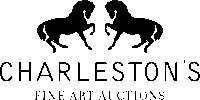Aboriginal Art
Long before the advent of European settlement, Aboriginal artists established a long and proud tradition of art that celebrated culture, customs, and the landscape. Neglected and often dismissed, it enjoyed a long overdue revival in the 80s and early 90s, and is now considered to be one of the most collectable art forms in the world today. Aboriginal art auctions regularly highlight the rich diversity of this art, offering works that range in size from small pieces to oversized corporate commissions, all works are accompanied by a certificate of provenance.
Charleston’s Fine Art Auctions often feature the work of many Aboriginal artists, including the following: Minnie Pwerle, Dorothy Napangardi, Polly Ngale, Gabriella Possum, Shorty Robertson, Judy Watson, Charmaine Pwerle, Makinti Napanangka, Betty Club Mbitjana, Michael Nelson, Gloria Petyarre, Long Jack Phillipus, Ronnie Tjampitjinpa, Jeannie Pitjarra, Anna Price Petyarre, Emily Pwerle, Sabrina Robinson, Felicity Robinson, Jorna Newberry, Glenys Gibson, Winnie Reid, Colleen Wallace, Galya Pwerle, Barbara Weir, Ningura Napurrula, Kathleen Petyarre, Nellie Marks Nakamarra, Marlene Young, Patricia Kemarre, Willie Tjungurrayi, Charlie Tjapangarti, Abie Loy Kemarre, Thomas Tjapaltjarri, Jeannie Mills, Alison Riley Munti, Trephina Sultan, Janet Golder, Samantha Daniels, Lynette Corby, Mitjili Napurrula, Barney Campbell, Lindsay Bird, Sabrina Granites, Bombatu Napangardi, Walala Tjapaltjarri, Margaret Lewis Napangardi, Lisa Mills, Mary Pitjara, Margaret Scobie, Bessie Pitjara and others.
Traditional Aboriginal Art
The Aboriginal societies have been producing art for thousands of years, including rock paintings, bark paintings, rock engravings, carvings, sculptures, and weaving. Aboriginal rock paintings can be found in sites across Australia, including in the Kimberleys and Pilbara in Western Australia, Kakadu National Park and Uluru in the Northern Territory, Olary District in South Australia, and the Sydney rock carvings found around the city. All traditional Aboriginal art has a spiritual meaning steeped with symbolism and storytelling related to the Dreamtime.
Aboriginal art for sale can be found at various galleries and auctions worldwide, making it accessible to collectors and art enthusiasts.
Contemporary Aboriginal Art
Today, most Aboriginal art in Australia is produced in community groups and art centres. One of the most famous Aboriginal art centres is the Papunya community in the Western Desert, northwest of Alice Springs. It’s famous for its dot paintings created by artists like Clifford Possum Tjapaltjarri and Johnny Warangkula. Aboriginal art auctions have become key events for collectors, offering contemporary works that reflect both tradition and modernity.
Contemporary Aboriginal artists use a range of materials and techniques, both traditional and modern. The materials used to produce paintings can vary from traditional ochres on bark to modern media like acrylic and oil paints on canvas.
Today, Aboriginal art is internationally recognised as fine art, with art critic Robert Hughes famously describing contemporary Aboriginal art as the “last great art movement of the 20th Century”. Aboriginal art is highly sought after by art collectors around the world, with high demand coming from Europe and the United States.
